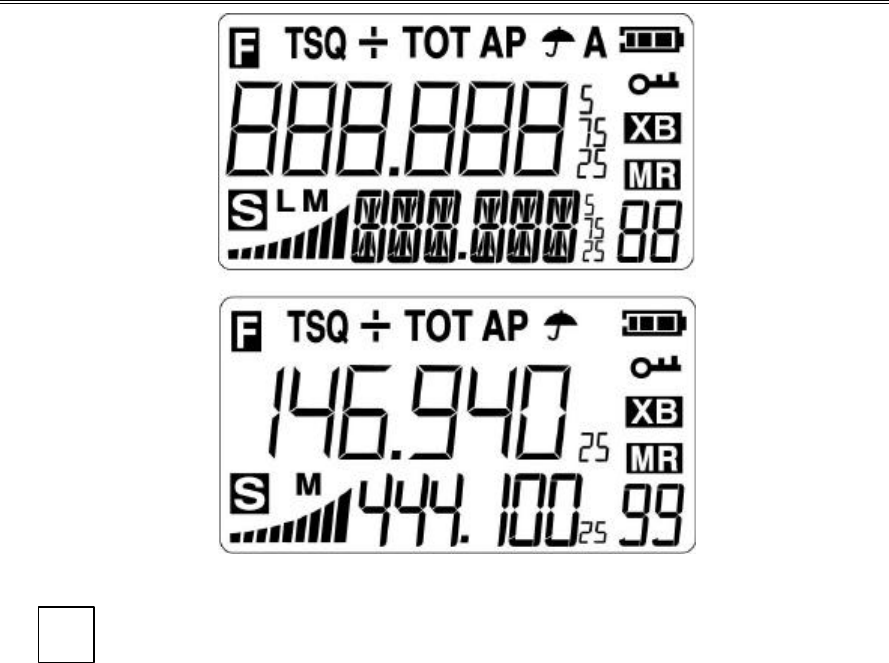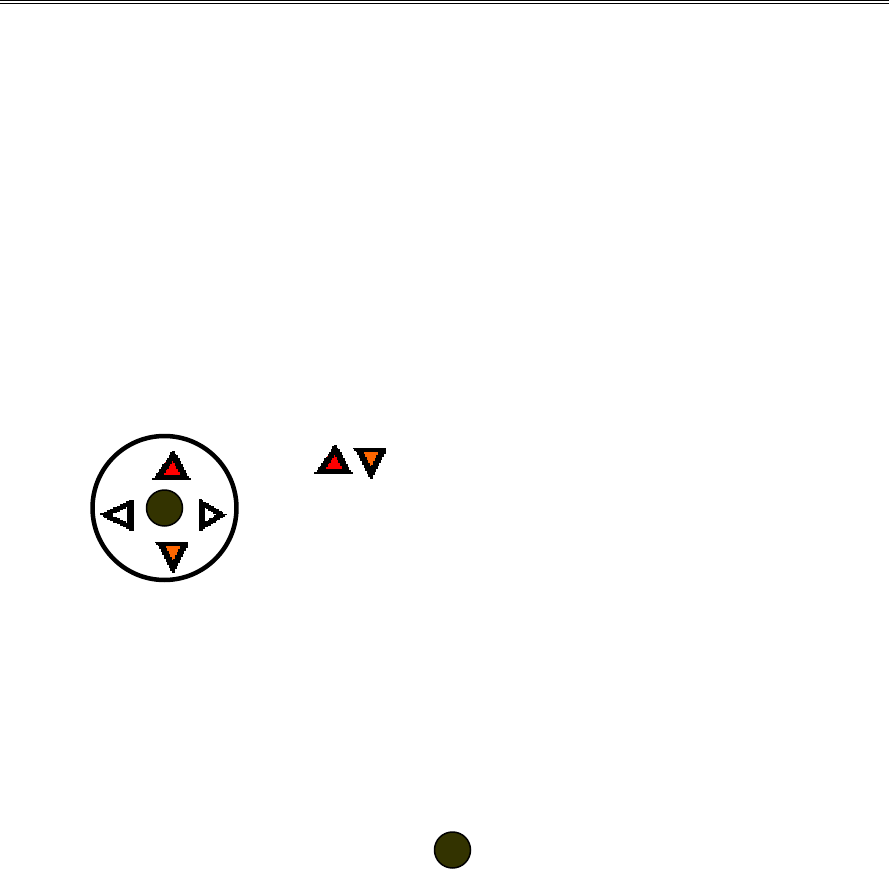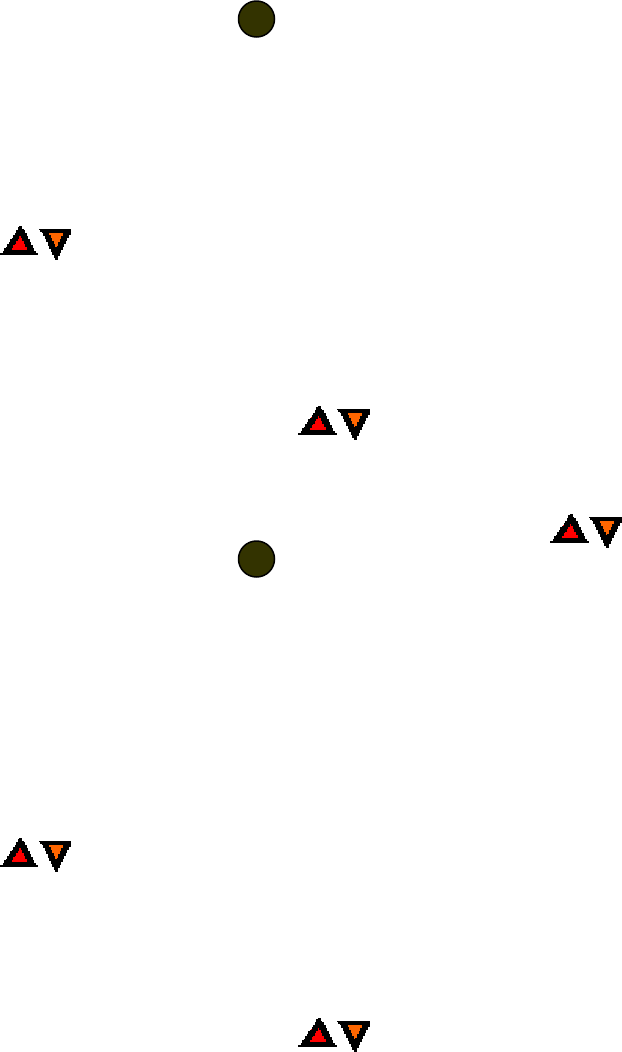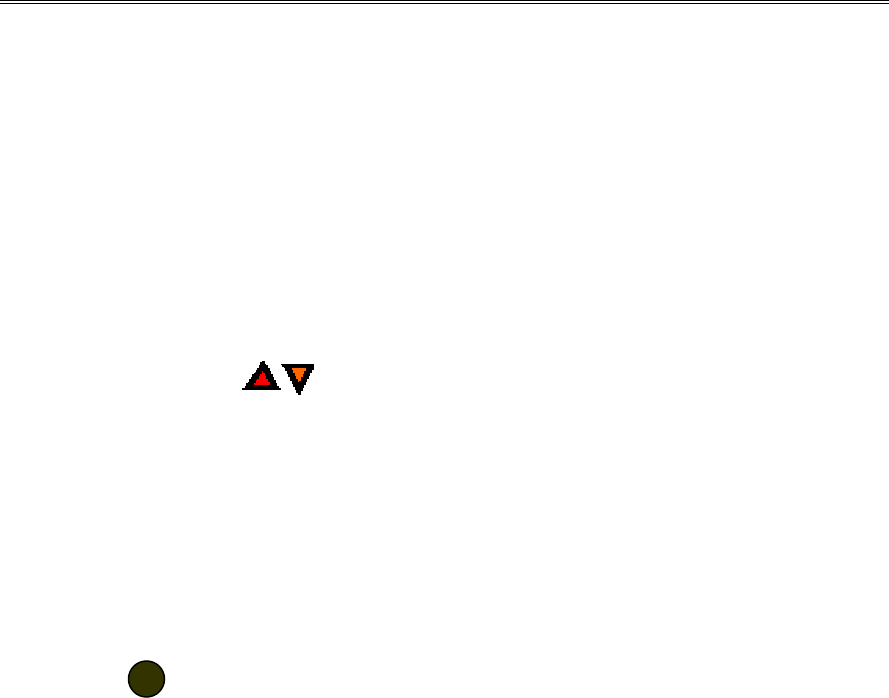Radio Shack 1901108 VHF/ UHF FM Handheld Transceiver User Manual 388K1 4 usersmanual
RadioShack Corporation VHF/ UHF FM Handheld Transceiver 388K1 4 usersmanual
users manual

BG TECH.
VERSION III
2001/2/28
Cat. No. 19-1108
OWNER’S MANUAL
Please read before using this equipment.
HTX-420
Compact Handheld 2m/70cm FM
Amateur Transceiver
®
RadioShack®
RADIOSHACK CORPORATION
FCC ID: AAO1901108
JOB #: 388K1
EXHIBIT #: 4

BG TECH.
VERSION III
2001/2/28
FEATURES
Your RadioShack Compact Handheld 2m/70cm FM Amateur Transceiver is compact and rugged, making it
easy to carry almost anywhere. The crystal controlled circuitry provides accurate and stable frequency
selection, making it an ideal choice for your amateur communications needs.
Note : You must have a Technician Class or higher Amateur Radio Operator’s License, and a call sign
issued by the FCC, to legally transmit using this transceiver. Transmitting without a license carries heavy
penalties. Getting a license is easier than ever. See “Introduction to Amateur Radio” on Page for more
information.
Here are some of your transceiver’s features.
Delux-Featured Dual-Band Radio – means flexible transmitting options with the latest built-in
conveniences. Its compact size and light weight are perfect for an amateur radio operation on the go.
Full 16-Key DTMF (Dual-Tone Multi Frequency) Keypad – lets you dial and make telephone connections.
Up To 5 Watts Output – The transceiver transmits at 5 output when powered by 13.8V External power
supply.
100 Memory Locations – let you store up to 100 frequencies and other settings.
S/RF and Battery Strength Meters – assure accurate signal and battery strength readings.
CTCSS (Continuous Tone Coded Squelch System) Subaudible Tone – both encodes and decodes 50
subaudible tones to help reduce interference from other nearby systems operating on the same frequency.
Repeater Offset – lets you select the offset value to match a local repeater.
Scan – the transceiver scans its full frequency range and 100 memory locations for transmissions.

BG TECH.
VERSION III
2001/2/28
Power Save – conserves battery power when the transceiver is not transmitting or receiving.
Programmable Frequency Steps – let you set the frequency increment for tuning or scanning to steps of 5,
6.25, 7.5, 10, 12.5, 15, 20, 25, 25, 50kHz.
Signal Strength Indicator – a graduated bar shows the relative strength of the received signal.
Time-Out Timer – lets you set a maximum transmission time interval among 1,2,3,4,5,10,15,20 minute.
Earphone Jack and External Microphone Jack – let you connect an optional earphone, external
microphone, or combination headset for more flexible operation.
External Power Jack – lets you use an external power source for maximum output.
Back Light – makes your transceiver easy to operate in low-light situations.
Weather SAME Alert – lets you watch specific area message from NOAA and listen to the weather
broadcast.
Auto Power Off – lets your transceiver automatically turn off after a preset period of non-use.
Electronic Compass – lets you know the directions.
Cross Band Operation – lets you use the different frequency for transmitting and receiving.
Dual Watch – let you watch two different channels.
Air band receiver – lets you listen to air band broadcast.

BG TECH.
VERSION III
2001/2/28
MANUAL CONVENTIONS
Your transceiver’s buttons perform multiple functions. The abbreviation or symbol for a function is printed on
or above each button.
To activate certain transceiver features, you must press F (function) and another button at the same time.
Those key combination instructions are printed as the first button name, +, then the second button name. For
example, F+ TOT means hold down F while you press TOT.
Button names are printed in small, bold, capital letters such as CLR or MR. Words, symbols, and numbers
that appear on the display are printed using a distinctive typeface, such as 146.940 or MR.
FCC INFORMATION
This device complies with Part 15 of the FCC Rules. Operation is subject to the following two conditions : (1)
This device may not cause harmful interference, and (2) this device must accept any interference received,
including interference that may cause undesired operation.

BG TECH.
VERSION III
2001/2/28
CONTENTS
Introduction to Amateur Radio
Preparation
Using Internal Batteries
Using Rechargeable Battery Pack
Testing Internal Batteries
Using Non-Rechargeable Batteries
Using AC Power
Using Vehicle Battery Power
Connecting the Antenna
Attaching the Belt Clip
Attaching the Wrist Strap
Connecting a Microphone/Speaker
A Quick Look at the Display
Operation
Turning On/Off the Transceiver
Changing the Channel/Frequency Up/Down
Changing the Volume Up/Down
Changing the Bands
Using Monitor Button
Using universal type e key for Set mode
Repeater Operation
Memory Operation
Storing a Transmit/Receive Frequency (Memory Writing)
Recalling Memory (Memory Reader)
Checking Memory Location Settings
Clearing a Single Memory
Using the Calling Frequency Memory
BG TECH.
VERSION III
2001/2/28
Scanning Operation
Scanning for Active Frequencies
Continues Tone Coded Squelch System Features
Using the CTCSS tones
Using DTMF Code
Transmitting a DTMF code from Memory
Transmitting a DTMF Code Using Direct Entry
Other Special Features
Locking the Keypad
Lighting the Display
Turning the Display and Keypad
Turning the Key Tone On and Off
Setting the Frequency Step
Power Save
Using Auto Power Off
Time-Out-Timer
Turing the Weather Radio Frequencies
Weather SAME Alert
Electronic Compass
TX Power Output Setting
Busy Channel Lock Out
Resetting
XBO Channel Operation
Dual Watch
Receiving Air band
Expanding TX Frequency range by Key pad Programming

BG TECH.
VERSION III
2001/2/28
INTRODUCTION TO AMATEUR RADIO
Your transceiver is the perfect first radio for anyone entering the exciting world of amateur radio, s well as a
great additional transceiver for the experienced amateur radio operator. Your transceiver opens a door for you
to the world from almost anywhere! All you need is an Amateur Radio Operator’s License (Technician Class
or higher) issued by the Federal Communications Commission (FCC). If you do not have a license, it is easier
than ever to get one, and help from licensed operators is available. Here are a few tips to help you get started.
You can turn on your transceiver and scan the entire band to hear what is going on; however, do not attempt to
transmit until you get your license. If you transmit without a license, you are in violation of federal law that
can lead to severe penalties. Note that ham operators take the FCC rules very seriously and want nothing to do
with “bootleggers” – their term for people who operate without a license.
Find out if there is a ham radio club in your area. Most clubs welcome new transmissions, write to the
American Radio Relay League (ARRL) at the following address to find out how to cntact a local affiliate. The
ARRL is the national organization representing amateur radio in the United States. The league has more than
150,000 members. Most are ham operators, or members in the process of obtaining their license.
The American Radio Relay League
225 Main Street
Newington, CT06111
http://www.arrl.org
Starting for the license exams. Do not be intimidated by the word “study” because most people can go from
knowing absolutely nothing about amateur radio to passing the Novice and Technician written exams in less
than a month.
The exams test your knowledge of basic radio regulations and elementary radio theory. Many clubs hold
license classes which can be a fun and easy way to learn about amateur radio. There are good books, cassette
tapes, computer programs, and many other study aids available. Your local RadioShack store sells FCC
License Preparation study guides for amateur radio operator licenses. While you are no longer required to
BG TECH.
VERSION III
2001/2/28
learn Morse code for a Technician Class license, we encourage you to learn it anyway so you can advance to
higher levels of operating privileges.
There is no fee to take the Novice exam. As soon as you pass the Novice exam, you can immediately take the
Technician exam. All license level tests are administered by a three-member Volunteer Examiner Team.
Contract the ARRL for a schedule of exam opportunities in your area.
The Technician Class license lets you use the transceiver to communicate directly with other operators, and
use repeaters for distant communication.
Amateur radio is a great hobby that has enriched the lives of millions of people all over the world. The ARRL
would be glad to hear from you if you need more information or would like to join!

BG TECH.
VERSION III
2001/2/28
PREPARATION
You can operate your transceiver from any of four power sources;
l Li-Ion batteries
l Alkaline batteries
l AC Power (using an optional AC adapter)
l Vehicle battery power (using an optional DC adapter)
USING INTERNAL BATTERIES
Using Rechargeable Batteries
You can power your transceiver using two lithium ion batteries supplied as a sealed pack.
The battery pack has a built-in circuit that lets you recharge Li-Ion batteries. To charge the batteries, connect
an supplied external AC to DC adapter to the battery pack’s CHG jack.
Caution) Please, clear the contact on the radio to the lithium ion battery pack with alcohol from time to time.
Testing Internal Batteries
To test the batteries, hold down PWR for about 1 second. The battery voltage briefly appears. The bars of
battery icon on LCD appears as a battery monitor indicator. There more bars in side the icon, the stronger the
batteries. When there are no bars in side of battery icon and flashes, recharge the battery or replace all the
batteries if Alkaline batteries are used as soon as possible.
Using Non-Rechargeable Batteries
You can power your transceiver using four alkaline batteries using alkaline battery.
USING AC POWER
You can power the transceiver using a 13.8V DC power supply with a size H Adapta-plug adapter. This is
available at your local RadioShack store.
USING VEHICLE BATTERY POWER
BG TECH.
VERSION III
2001/2/28
You can power the transceiver from a vehicle’s 13.8V power source or cigarette lighter socket using 13.8 V
DC to DC power adapter and a size H Adaptaplug (neither supplied). Both are available at your local
RadioShack store.
CONNECTING THE ANTENNA
Place the threaded base socket of the supplied antenna over the antenna connector on the top of the
transceiver and turn the antenna clockwise to tighten it. To remove it, turn it counterclockwise.
Caution : Do not over-tighten the antenna
Note : You can connect an external antenna to the transceiver using an SMA to BNC adapter. This adapter and
suitable antennas are available at your local RadioShack store.
ATTACHING THE BELT CLIP
Use the Philips screwdriver and the two supplied screws to attached the supplied belt clip to your transceiver.
Do not over-tighten the screws.
ATTACHING THE WRIST STRAP
To attach the supplied wrist strap to the top of the belt clip, thread the strap’s small loop through the opening
in the top of the clip. Then insert the longer loop through the smaller loop and pull on the strap until the loop
is tight.
CONNECTING A MICROHONE/SPEAKER
You can connect an external communications headset (consisting of a microphone and speaker) to the
transceiver so you can use it privately. Lift the hinged, rubber dust cover from the MIC and SPK jacks on top
of the transceiver. Then insert the plug of an optional voice activated headset with microphone, or an optional
communication headset, into the jacks.
Caution : Use only microphone and speaker accessories that do not share a common ground for the speaker
and microphone. Doing otherwise might damage the transceiver.
BG TECH.
VERSION III
2001/2/28
Note : Connecting a headset’s plug to the transceiver’s SPK jack automatically disconnects the internal
speaker.
You can also connect an optional mono earphone to the SPK jack. This lets you use the transceiver’s push-to
talk button to transmit as usual. Your local RadioShack store carries a wide selection of suitable
communication headsets, earphones, and separate components.

BG TECH.
VERSION III
2001/2/28
A QUICK LOOK AT THE DISPLAY
1. : : it will appear when F (function) key is pressed.
2. TSQ
This is for the function of tone squelch (CTCSS).
“T” will appear when Tone Squelch (CTCSS) is enabled for transmitting.
“SQ” will appear when Tone Squelch (CTCSS) is enabled for receiving.
“TSQ” will appear when Tone Squelch (CTCSS) is enabled for transmitting and receiving.
3. +/- : “+” will appear to indicate a positive repeater offset. “ –“ will appear to indicate a negative repeater
offset.
4. TOT : “TOT” will appear when a time for the time out timer is selected.
5. AP : “AP” will appear when Auto Power Off is enabled.
6. Icon of umbrella : This icon will appear when Weather Radio is enabled. When it goes out of range, this
icon blinks.
F
BG TECH.
VERSION III
2001/2/28
7. A : This icon shows when RX mode is in Air band.
8. battery icon : Battery icon indicates the battery strength.
9. B (key symbol) : this indicates that the key pad control is disabled to prevent accidental setting changes.
10. XBO : This is “Cross Band Operation”. When you use different frequencies for TX and RX, this will
indicate you are using cross band operation.
11. MR (memory Channel Recall) : let you select a memory location using CH.
12. S: This appears when there is a receiving signal as a receiving indicator. When it is flashes, power save
mode is enabled.
13. LM: “L” indicates the low TX power position . “M” indicates the mid TX power position.
14. SIGNAL INDICATOR BAR: It shows the relative signal strength.
15. Main Frequency display in the middle: This is to show RX frequency
16. Sub Frequency display in the bottom: This is to show TX frequencies and alphanumeric characters and
Compass. In compass mode, the first 2 digit will show the direction in Alph. such as NW, SE, or
something. And the last 3 digits will show the degree of direction such as 360, 180, 90, 45.
17. 2 digits below “MR” : This is memory address.

BG TECH.
VERSION III
2001/2/28
OPERATION
TURING ON /OFF THE TRANSCEIVER
To turn the transceiver, hold down “PWR” key for about 0.5 second. The radio beeps once if the key
tone feature is enabled. Then the current battery voltage briefly appears and the last used frequency
appears. To turn the transceiver off, press “PWR” key again.
CHANGING THE CHANNEL/FREQUENCY UP/DOWN
To change the channel or frequency, turn the rotary switch on the top. If you turn clockwise, channel
or frequency goes up. If you turn counterclockwise, channel or frequency goes down.
Also you can use the universal type keys to turn up/down.
F + are pressed to step through the frequencies in 1MHz steps
(144, 145, 146)
Also, you can enter the frequency you want to use directly pressing 16 keys.
CHANGING THE VOLUME UP/DOWN
To change the volume, turn volume switch under the channel switch clockwise for up or counter
wise for down.
CHANGING THE BANDS
To change the band you want to use, press and it will turn VHF, UHF, AIR BAND, WX.
USING MONITOR BUTTON
To temporarily open the squelch, hold down “M”. To resume normal operation, release M.
While “M” is pressed, SQL, RPT, RXTONE, TXTONE is displayed on the sub frequency display
and its value on the main frequency.

BG TECH.
VERSION III
2001/2/28
USING UNIVERSAL TYPE KEY FOR SET MODE
Press or repeatedly to select setting SQL 0 ~ 5, VHFRPT, UHFRPT, RXTONE,
TXTONE, DTMF, AREA code set, SAME on/off mode in turns.
If you select a setting you want to change, press to change value.
Setting the squelch level :
Press to change the squelch setting. “00 ~ 05” on main frequency display and SQL
on sub frequency display will appear.
VHFRPT : VHF Repeater frequency setting.
When you select value pressing up/down arrow key or rotating rotary switch,
press to save and exit.
Repeater offset frequency range : 0KHz to 8MHz
Default frequency step : 5KHz
Default repeater offset : 600KHz
Default repeater offset step : 5KHz
UHF RPT : UHF Repeater Frequency Setting
When you select value pressing up/down arrow key, press to save and exit
Repeater offset frequency range : 0KHz to 8MHz
Default frequency step : 12.5KHz
Default repeater offset : 5MHz
Default repeater offset step : 100KHz
RXTONE : RX CTCSS Frequency Setting
When you select a frequency or no frequency (CTCSS off) pressing up/down arrow key,
press to save and exit
Default is “88.5”.

BG TECH.
VERSION III
2001/2/28
TXTONE : TX CTCSS Frequency Setting
When you select a frequency or no frequency (CTCSS off) pressing up/down arrow
Key or rotate a rotary switch, press to save and exit
Default is “88.5”.
dTMF : DTMF dial Setting
à Initial Data Entry
1. Press KEY to select DTMF mode.
2. Press or rotary switch to select the address from d1 to d6.
3. Main frequency display shows ------. On the sub-frequency display, dTMF will be
displayed and memory display shows d1 to d6.
4. Enter the code by pressing 16 keys. If you try to enter mode than 16 digits, the radio
sounds two short beeps to indicate the error.
5. To enter the code to another address, press or rotate the rotary switch.
The data in the previous address is stored automatically.
6. Do the same way of 4.
7. To reconfirm DTMF code, hold down “F” and rotate the rotary switch or F +
8. After entering DTMF code, press or PTT key to go to VFO mode.
à Data re -entry
1. Select the address to modify.
2. Enter the desired data.
WX-Area Code Setting mode.
à Initial Data Entry
1. Press KEY to select Area setting mode.
2. Press or rotary switch to select the address from A to A9.
3. Main frequency display shows ------. On the sub-frequency display, AREAF will be
displayed and memory display shows A1 to A9.
4. Enter the code by pressing 16 keys. If you try to enter mode than 6 digits, the radio
sounds two short beeps to indicate the error.
5. To enter the code to another address, press or rotate the rotary switch.
The data in the previous address is stored automatically.

BG TECH.
VERSION III
2001/2/28
6. Do the same way of 4. and 5.
7. After entering AREA code, press or PTT key to go to VFO mode.
à Data re -entry
1. Select the address to modify.
2. Enter the desired code.
- Once area code is entered, WX SAME mode works only area code is matched.
- If there is no data in A9, ------ appears.
WX-SAME : Weather SAME Mode On/Off
When you select WX SAME mode on or off pressing up/down arrow key, press
to save and exit. (If mode is On, umbrella icon will appear when the radio is
tuned in weather channel.)
Display: Main : OFF-ON, Sub : SAME.
REPEATER OPERATION
Press “F” + “+/ -“ to select +. -, or OFF.
If main frequency display shows 144.000 for instance, sub frequency display shows +600.
When “REV” is pressed, “+” will be changed to “-“. On pressing “PTT”, sub frequency display
shows – 600.
If frequency is out of the amateur band, error tone sounds.

BG TECH.
VERSION III
2001/2/28
MEMORY OPERATION
Your transceiver has 100 standard memory locations that you can use to store frequencies for quick access.
You can store frequencies used for the VHF, weather, and UHF bands. When you store a frequency, all other
settings associated with that frequency (such as the repeater offset and CTCSS tones) are stored as well.
STORING A TRAMSMIT/RECEIVE FREQUENCY (MEMORY WRITING)
Select the freq. you want to store. Once you selected a frequency, the other values such as the
repeater offset and the CTCSS tones for that frequency are also stored in the memory location.
Press “F” + “MW(MR)”. The last used memory location appears and MR flashes on the display.
Repeatedly press arrow key or turn CH rotary switch to select the desired memory
location. Press “F + MW” again to store the selected frequency and exit the memory mode. You
can use up to 100 memory locations to store the frequency.
RECLLAING MEOMIRES (MEMORY READER)
To recall saved memory settings, press “MR”. MR appears and the last used memory location
number appears beneath MR. Then rotate or press CH switch or up/down keys to select a different
memory location. When pressing “SC”, it scan memory channels To return the VFO mode,
press .
.If there is a channel skipped, “MR” blinking. On scan mode, this channel is skipped. If “SC” is
pressed again, it returns to VFO. In scan mode, if there is a signal, it will stop for 8 sec. and scan
again.
CHECKING MEMORY LOCATION SETTINGS
Press “MR”, then rotate CH switch (or press up/down arrow keys) to select the memory location.
Then hold down “M” key. The settings stored in the memory in the memory location appear in
sequence starting with the squelch setting value and ending with the frequency.
CLEARING A SINGLE MEMORY
Press “F” + “CLR(6)” to clear the selected memory location. The next location in sequence appears.
BG TECH.
VERSION III
2001/2/28
Memory No. 1 will not be cleared.
USING THE CALLING-FREQUENCY MEMORY
Press “Call” key to display the current calling frequency. The frequency appears. To change the store
frequency, press F + Call (CM) after enter a new frequency in VFO. To enable the calling frequency,
press “CALL” key at any time.

BG TECH.
VERSION III
2001/2/28
SCANNING OPERATION
SCANNING FOR ACTIVE FREQUENCY
Press “SC” key to scan up or down the band’s full frequency range. The decimal point flashes as the
transceiver scans. The radio stops on each active frequency for 8 seconds. To change the scanning
direction, press up or down arrow key or rotate the rotary switch. To stop on a frequency or stop
scanning, press “SC” or PTT key again.

BG TECH.
VERSION III
2001/2/28
CONTINUOUS TONE CODED SQUELCH
SYSTEM FEATURES
Your transceiver can transmit and receive a low-level, selectable, subaudible tone at the same time as it
transmits (TX) or receives(RX) a regular signal. This special tone lets you listen only to other radio set to the
same tone frequency when you use the transceiver in simplex operation. It also lets you match your radio to
the subaudible tone frequency used by a local repeater.
USING THE CTCSS TONES
To enable only the transmit (TX) tone, press “F” + “T.SQL(1)” key. T appears above the displayed
frequency. To enable only the receive (RX) tones, press F + T.SQL(1) key and then SQ appears
above the displayed frequency. To enable Both TX and RX tones, press “F” + “T.SQL(1)” key again
and then TSQ appears above the displayed frequency.

BG TECH.
VERSION III
2001/2/28
USING DTMF CODE
DTMF (Dual-Tone Multi-Frequency) tones are those typically associated with the use of your telephone. Your
transceiver can tranmit up to 16 separate DTMF tones and store a sequence of tones in up to 6 different
memory location (d1 to d6). You can use DTMF to transmit to a land-patch and then to a telephone line. This
lets you enable or disable certain repeater functions, which is handy if you are involved with repeater
administration. You can also signal to another radio equipped to receive DTMF codes.
TRANSMITTING A DTMF CODED FROM MEMORY
Press “F” + “D.SEL” and , select desired the DTMF code memory pressing up or down arrow key or
rotary switch. Press or PTT or “F + “D.SEL” to exit to VFO mode.
Press “PTT” + , to transmit a DTMF in memory.
TRANSMITTING A DTMF CODE USING DIRECT ENTRY
Hold down “PTT” and enter each character of the desired DTMF code in order. There is no limit on
the number of DTMF characters.
DTMF code is displayed on the sub frequency disply and if there is no entry for 3 sec while pressing
“PTT”, the last used data is displayed. If you re-enter the character, it will continue to display after
the last used data.

BG TECH.
VERSION III
2001/2/28
OTHER SPECIAL FEATURES
LOCKING THE KEYPAD
Press “F” + “Lock (DW)” key. To unlock the keypad, press “F” + “Lock”.
PWR won’t be locked.
LIGHTING THE DISPLAY
When you press any key except “PTT” or “F” , the backlight turns on for about 5 seconds.
TURING THE KEY TONE ON AND OFF
Press “F” + “BEEP (7)” to turn on and off.
Display : Beep on à BP ON Beep off à BP OFF
SETTING THE FREQUENCY STEP
Press “F” + “STEP(2)”. The current step setting appears with “STEP” on LCD.
Repeatedly, press key or channel rotary switch until the desired new setting appears.
You can change the frequency step to 5, 6.25, 7.5, 10, 12.5, 15, 20, 25, 50KHz.
Press or “PTT” to store your selection.
POWER SAVE
Press “F” + “PS(5)”. appears.
AUTO POWER OFF
Press “F” + “APO (3)”. Auto Power Off is normally disabled. OFF appears.
Repeatedly press either up or down arrow key or channel rotary switch to select a time period until
power shut off.
You can select Off, 30, 60, 90, or 120 minutes.
Press “PTT” or to store your selection and exit to the VFO mode.
To turn off the auto power off feature, press “F” + “APO”.
TIME-OUT-TIMER
S

BG TECH.
VERSION III
2001/2/28
Press “F” + “TOT(4)”. The default setting OFF appears with TOT on LCD. Repeatedly press
key or channel rotary switch to select the desired time -out-timer interval from 1, 2, 3, 4,
5, 10, 15, 20 min. When you select a value for the time -out-timer feature, “TOT” appears on the
LCD. Press to store the setting and exit to the VFO mode.
When TOT is on, “TOT’ on LCD is blinking.
For instance, when it is set to 4 min, warning tone beeps at 3min 50 sec.
TURING THE WEATHER RADIO FREQUENCIES
Press to select weather band. Then, press to select your local weather channel.
Main channel display will show CH-01 and sub channel display will show WX.
When SAME is on, sub channel display will show SAME.
WEATHER SAME ALERT
Press to select SAME mode. Press up/down key to select weather SAME on or off. When
you set Weather SAME area code and weather SAME is on, the transceiver detect the SAME signal
and display in WX Channel as below
WARN for Warning
WATCH for Watches
STMT for Statement
TEST for Test
Umbrella icon appears when SAME mode is on.
It detects SAME code in selected weather Channel. During SAME code detects, audio is muted.
Main channel display shows the selected weather channel and sub channel display shows one of
alerts (WARN, WATCH, STMT or TEST) for 5 sec.
If area code is not designated, it will not detect 4 kinds of alert.
Area code can be input only in AREA mode on set mode.
(Reference of Area code at http://www.nws.noaa.gov/nwr/nwral.htm)
ELECTRONIC COMPASS
Press “F” + “COMP (H/L)” to see magnetic direction.
2 digits of direction such as SE, NW appear in the left and up to 3 digits of degree such as 360, 180,

BG TECH.
VERSION III
2001/2/28
090, 045, 005, appear by 5 degree step in the right on the display.
For calibration of compass, press “PWR” + “COMP” key and then confirm the display “CAL”.
Then, turn the unit twice clockwise or counterclockwise. And then press “PTT” or to return to
normal mode.
To see the more precise compass direction, have the unit horizontal.
The display provides 8 primary directions ; N, NE, E, SE, S, SW, W and NW.
On the mode of XBO, compass will be displayed unless the radio is receiving the signal.
If the radio receives signal, it shows the frequency.
While pressing any key, frequency appears.
TX POWER OUTPUT SETTING
Press “H/L” key repeatedly. You can select High (No display), Mid (display: M), Low(display : L)
in turn.
SKIP
Press “F” + “M (SKIP)” to turn this feature on or off. When SKIP is on, "MR" is blinking.
SKIP works in only memory channel.
RESETTING
To reset, press “6” + “MR + “PWR”.
XBO CHANNEL OPERATION. (Main channel : RX, Sub channel : TX)
Press “F” + “XBO(SC)”. “XB” appears on the LCD. Enter main frequency for RX frequency
and then press “F”+ “REV(8)” to switch to sub channel with main channel. Enter frequency to
main channel.
DUAL WATCH
If radio is in VFO mode, press ”DW” to enter dual watch. Enter the frequency you want to watch
on the main-freq. display by keying in the frequency or read the memory. (Default is the last
memory channel).
The radio scans in main frequency for 200 msec and sub-frequency for 2.5sec.
If main (VFO or memory channel) is not active, it scan sub (VFO or memory channel).
If main is active, it receives in main. If it drops out, it waits for 2.5 sec. During this time, if the radio

BG TECH.
VERSION III
2001/2/28
don’t receive in signal, it goes to scan in sub. If pressing PTT, it transmits in last memory channel
before entering the dual watch mode and dual watch is canceled.
If “M” key is held down, it scans in sub frequency till "M" is released. If released “M” key, it waits
200 msec in main channel and back to the sub frequency.
The initial frequency in main and sub. is same.
RECEIVING AIR BAND
Select Air band frequency by pressing and tune the frequency you want to hear pressing
or rotate Ch rotary switch. When the mode is air band, “A” appears on the top of LCD.
The air band RX range is 108.000 ~ 136.9875MHz.

BG TECH.
VERSION III
2001/2/28
SPECIFICATION
GENERAL
Frequency
2-Meter ----------------------------------- TX:144 ~148MHz/RX: 137 ~ 174MHz
70-cm ----------------------------------- TX:438 ~450MHz/RX: 420 ~ 512MHz
Weather Channel ------------------------------------ RX : CH1 ~ CH7
Airband ----------------------------------- RX : 108.000 ~ 136.9875MHz
Frequency Generation --------------------------------- PLL Synthesizer
Frequency Stability ---------------------------------- +/- 10 ppm
Operating Temp. ---------------------------------- 32’ to 140’ F (0’ to 60’C)
Operating Voltage ------------------------------------- DC 5V to 12 V
Modulation ---------------------------------- F3E
Impedance ---------------------------------- 50ohm
Dimension (HxWxD) ---------------------------------- 4 1/2 x 2 2/5 x 1 1/5 (122 x 61 x 31 mm)
Weight (with CHG. Battery) ------------------------- 10.6 oz
(300g)
RECEIVER
Circuit Type ---------------------------------- Dual Conversion, Superheterodyne
IF Freq.
1
st IF ---------------------------------- 45MHz
2
nd IF ----------------------------------450kHz
Sensitivity ---------------------------------- 02uV For 12dB Sinad
Distortion ---------------------------------- 5% max
S/N Ratio ---------------------------------- 40dB min.
Audio Output @ 10%THD ---------------------------------- 400mW at 8ohm
TRANSMITTER
Power Output ---------------------------------- 3W, DC 7.2V
5W, DC12V
Distortion (Nominal) ---------------------------------- 3%
BG TECH.
VERSION III
2001/2/28
Deviation ---------------------------------- +/- 5kHz MAX.
S/N Ratio ---------------------------------- 40dB
Current Drain ---------------------------------- 1200mA, DC 7.2V
1500mA, DC 12V